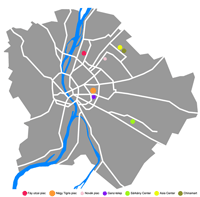Budapest - Chinatown
The built environment of Far Eastern immigrants and their use of space
When we consider the architectural presence of Far Eastern immigrants in Budapest, in a physical sense, what we first find is that there is no so-called Chinatown. What we have instead is a loose and irregular network, with various key points of concentration as its nodes (markets, shopping centres, major restaurants), whose visible built elements are the stages of the immigrants' most important activities, commerce and catering, as well as the facilities servicing these.
The reason for this may be that Far Eastern immigrants began to appear in Hungary in the mid-1980s, when a Chinese district could no longer find its place within the fabric of the city. Nonetheless, there appeared central places linked to the immigrants, spaces that could accommodate them in great numbers because they were out of use (railway facilities, abandoned industrial spaces), and the newcomers could utilise them with a minimum of intervention and modest investment. Wherever they appeared outside these centres, they also filled vacancies: Chinese restaurants and shops took over closed-down facilities, and their arrival was unique only in that they were different from what the locals were used to - because "native" shops and restaurants do replace one another, after all. We face a considerably greater challenge if we also want to say something about what to the casual onlooker is the immigrants' "invisible" presence, because it is difficult for outsiders to learn much about their living conditions or places of recreation.
We began our investigation with the built environment of one of the chief activities of the immigrants: commerce. We started with a major point of concentration, the Józsefváros market [in the Josefstadt district of Budapest], which is called the Four Tigers market in Chinese, and which is a major node of the Far Eastern migrant community. (Everyone knows the market, and it has an exceptionally large turnover, yet its architectural solutions are completely temporary and flexible.) We followed up this line by looking at other important units of Chinese commerce in the city. (Note that Hungarians do not distinguish between the various Far Eastern immigrants, and all markets and restaurants are "Chinese," even if they are owned by Vietnamese, Mongolians, etc.) We applied the same criteria to all commercial establishments, from markets to shopping centres. We were looking for special architectural solutions; the similarities and correlations between the various places; the reasons for, and the hierarchy of, individual variations (cf. The Architecture of Far Eastern Commerce); the functions they fill in their urban contexts; their effect on the invisible elements of the migrants' presence.
The most salient characteristic of the architectural solutions of the shops and restaurants in the city is that they make a direct reference to being owned or run by Asian immigrants. In the case of shops, this rarely goes further than advertising the store as Chinese on the signboard, while the architecture is hardly different from that of other businesses in the neighbourhood. They, however, use the available space the same way as those commercial establishments where Asians are present in great concentration - characterised by a conspicuous density of goods, a highly efficient use of space - so often the merchandise itself becomes an "architectural" element, defining spaces or making "façades", though this of course is more striking in the markets. Similarly, restaurants restrict themselves to the use of ornaments typical of Chinese/Asian culture, the intervention always being superficial, never affecting the structure of the building; the only function of the ornamentation is to suggest that the building belongs to, and represents, Chinese culture.
 
Estimated layout of Far Eastern shops in Budapest / Points of concentration of Far Eastern migration in Budapest
In considering the living spaces of Far Eastern immigrants and their use of urban space, we find that so-called soft systems are far more important for them than the built environment. They seek to establish social and business relations, which they can utilise for their purposes. The result is a constantly transforming, loose system, which can flexibly respond to the changes of the city. Far Eastern culture and the culture of the city combine to produce what is the migrants' presence.
 
Estimated layout of Far Eastern residential areas in Budapest / Estimated layout of Far Eastern restaurants in Budapest
Their architecture, which is mobile like Far Eastern culture itself, and which is of secondary importance in relation to the social network, fills like a fluid the empty spaces of the city, itself immobile, heavy, defined by the built spaces, and does so without affecting considerable physical or structural changes, or even provoking an interaction. This may be why this ever-changing and ever-adaptive fabric cannot be altered from the outside, retains its flexibility only in its natural "habitat", and becomes resistant to external forces. A good example is the shopping centre called Asia Center, in whose case the investment and the development came as external forces, which did not acknowledge the nature of what is a self-regulating system, and have met with failure (for details cf. The Architecture of Far Eastern Commerce).
Gergely Kovács, Ida Kiss, Melinda Matúz
|